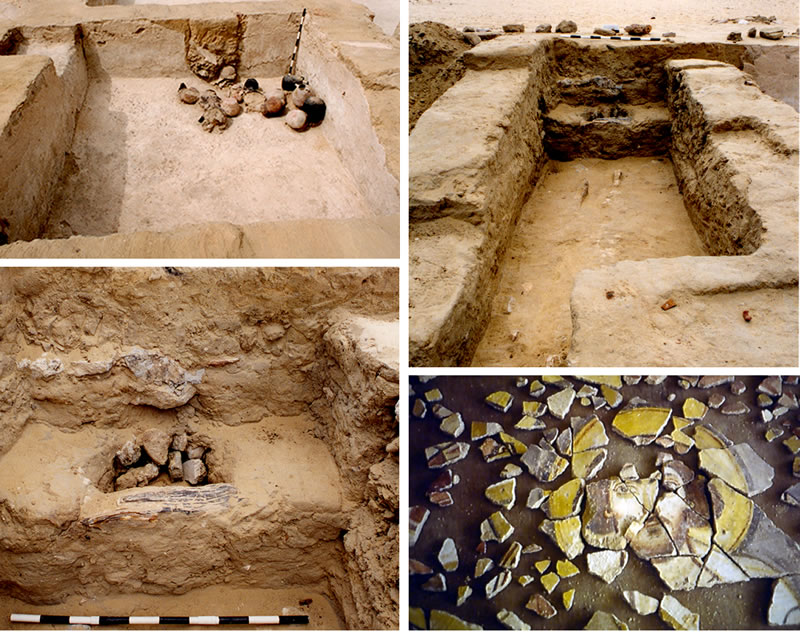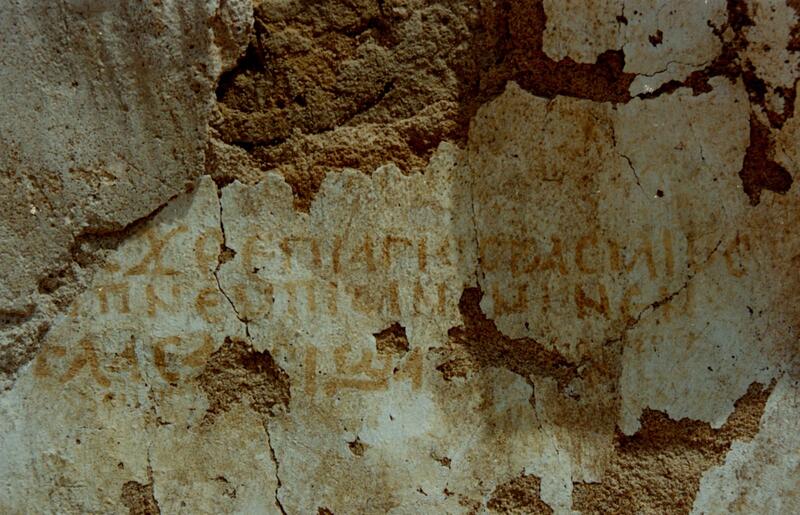Residence A
Residence A, located south of the main church complex, was partially excavated by the team sponsored by the Scriptorium of Calvin Theological Seminary in the 1990s.
As part of YMAP-North’s survey of the archaeological zone, Dawn McCormack produced a new plan of the building in 2010. Photo-documentation of the paintings and dipinti held in storage was completed by Stephen Davis from 2011 to 2014. The original Scriptorium documentation is currently being reassessed by Darlene Brooks Hedstrom and collated with the findings of her 2010 archaeological observations.
The multi-roomed monastic dwelling underwent several building phases. The central structure was adapted and expanded to accommodate more cells, prayer areas, and cooking facilities. A prayer area and a double hall were added during the second phase of construction, and both contained the fragmentary remains of wall paintings with images of Christ and the saints, angels, and monks (fig. 1).[1]

Figure 1. Residence A: room with in situ pottery deposit on the floor (upper left); latrine (upper right), with detail of seat made of petrified wood (lower left); fragments of a wall painting of a saint (lower right).
The double room hall at Residence A most closely parallels designs at Kellia where larger rooms were sometimes built to accommodate more guests as such sites increased in popularity as a places for pilgrimage. The painted fragments recovered from this room included one with an inscription identifying one face as that of Poemen, a well-known desert father of Scetis.[2] Another Coptic inscription invokes the name of Saint Basil (fig. 2).

Figure 2. A Coptic inscription in Room 8 of Residence A, invoking the name of Saint Basil.
The ceramic material collected by the Scriptorium team ranged in date from the early fourth to the eleventh centuries and included fragments of marl glaze ware (so-called ‘Fayoumi ware’) typical of the ninth to mid-eleventh centuries.[3] The probable occupation of the dwelling somewhere in the seventh to ninth centuries is suggested by the recovery of over forty complete Egyptian silt amphorae of a type circulating at this time.[4]
[1] B. Van Elderen, “Preliminary Report-Wadi Natrun Excavations: 1995 Season,” submitted to the Supreme Council of Antiquities, 27 March 1995; Personal observation by Darlene Brooks Hedstrom in 1995; R. Wicks, “Supervisor’s Report for Area AB,” submitted to the Wadi Natrun Excavations, April 1996.
[2] E. Bolman, “Preliminary Report on the Wall Paintings at John the Little,” submitted to the Wadi Natrun Excavations, April 1996.
[3] For this type, see G. Scanlon, “Fayyumi Pottery: A Long-lived Misnomer in Egyptian Islamic Ceramics. Type I,” Bulletin de la Société archéologie d’Alexandrie 45 (1993), 295–330. For a recent characterization of Egyptian glazed wares, including so-called ‘Fayoumi ware’ see R. B. J. Mason, Shine Like the Sun: Lustre-Painted and Associated Pottery from the Medieval Middle East (Bibliotheca Iranica: Islamic Art and Architecture 12; Toronto 2004), 61–90, pls. C2–C4.
[4] For this amphora type, see D. Dixneuf, Amphores égyptiennes. Production, typologie, contenu et diffusion (IIIe siècle avant J.-C. – IXesiècle après J.-C. (Études Alexandrines 22; Alexandria 2011), 154–173, figs. 145–174 (type AE 7).
